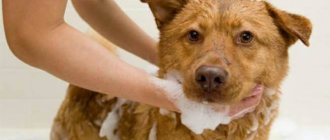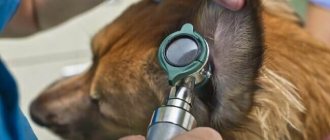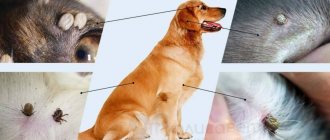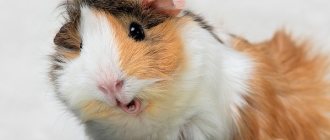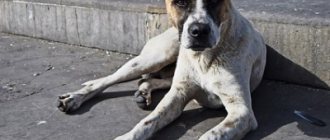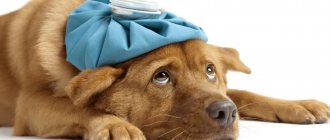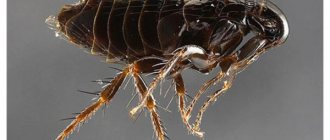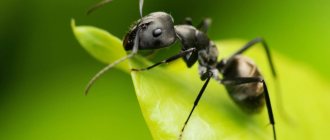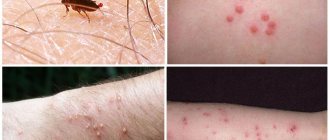Characteristic manifestations occur: wounds form on the skin, the fur looks disheveled and unkempt.
The disease caused by the canine lice eater is called trichodectosis or mallophagosis. You can fight it in different ways. The owner decides which one is suitable after consulting a doctor.
Infection process and symptoms
There is only one way of infection by lice eater - through direct contact:
- Contact with an infectious animal. Most often, when interacting with stray animals, pets become infected with lice and fleas.
- Even if we exclude any interaction between a domestic dog and any stray animals, there is still a risk of infection. Lice eaters are too small to be seen with the naked eye, and a dog owner may unknowingly carry the parasite on their hands, shoes or clothing.
- From mother to puppy, with direct contact.
If an animal is infected, but there are still few parasites and they are not active enough, it is very difficult to detect them. But when lice eaters multiply, the disease can be identified by the following symptoms:
- The dog experiences severe itching, which is why it scratches constantly.
- The presence of light flakes in the dog's fur, similar to dandruff. Lice eaters are sedentary parasites, but upon very careful examination you can see how these “flakes” move.
- The dog's fur becomes dull, brittle, becomes matted and sticks together.
- Partial baldness may occur - the inner thighs and base of the tail are especially susceptible to this.
- When there are a lot of parasites and they cause severe discomfort to the pet, the dog may lose its appetite, become apathetic, and lose weight.
We recommend reading the article: “Fleas on dogs: how to get rid of parasites, a review of the best remedies.”
Possible complications
Long-term infection of a dog with lice eaters can cause the development of dermatological diseases, the appearance of wounds and scratches on the pet’s skin. It is possible to develop helminthiasis, which is carried by parasites. Due to severe itching, the animal becomes irritable and aggressive. In addition, exacerbation of chronic diseases, if any, is likely.
Appearance of the parasite (photo)
The lice beetle belongs to the order of lice and lice. This is a very small insect with a flat body. The length of the parasite is about 1 mm, the color ranges from grayish, transparent to yellow. On the skin of an animal, the lice eater looks more like particles of dandruff than a parasite.
The body of the lice eater looks very much like a louse or a flea, but there is one distinctive feature - the shape of the head. In the lice eater it is wide, wider than the body. The parasite feeds not only on blood and lymph, but also on particles of skin and fur.
The lice beetle reproduces very quickly. The female lays about 70 eggs during her life cycle, which are attached to the animal’s fur using a sticky liquid. After about a week, larvae emerge from the eggs, which only a month later become adults, having previously gone through three stages of molting.
Danger to your pet
The ectoparasite, which is the lice eater, not only brings discomfort to the animal, but can also be a carrier of helminths and be a catalyst for the development of other unpleasant and dangerous diseases.
If there are lice eaters on the dog’s body, there is a very high probability of developing trichodecosis.
Lice eaters cause severe itching in the dog and, by furiously combing and biting the fur, the pet injures itself, and open wounds appear that can become infected.
The presence of parasites in general greatly weakens the dog’s body, immunity decreases, and chronic diseases or allergic reactions can worsen. Due to a decrease in the body's protective functions, the dog is susceptible to various viral or infectious diseases.
Photo gallery
Photo 1. Lice eater under a microscope
Photo 2. Lice beetles on wool
Photo 3. Poison beetles under a microscope
Photo 4. The dog and the consequences of the “work” of lice eaters
Photo 5. Bald patches on a dog
Photo 6. Lice eater close-up
Treatment
Despite the frightening symptoms of the disease, lice eaters are destroyed quite simply. The main thing is to start treatment as early as possible, without leading to concomitant diseases or the development of infection. Drops, shampoos, sprays or insecticidal collars will help get rid of the parasite.
Drops
The most common remedy for getting rid of fleas and lice are drops. Today, the market offers a huge variety of different drugs to combat parasites - both industrial, with the addition of various chemical compounds, and based on natural oils or decoctions.
- Based on various chemicals. They consist of a combination of various substances with an insecticidal effect.
- Based on pyrethroids (the active substances are permethrin, (ci)phenothrin, flumethrin), the most common products in the form of drops are UltraGuard (from 800 to 1200 rubles per pipette, depending on the weight of the dog); Bars drops (from 115 to 300 rubles depending on weight); beaphar (from 170 rubles per pipette).
- Based on phenylpyrazoles (active ingredients fipronil, pyriprole): Frontline drops (from 580 to 800 rubles per pipette); Bars Forte drops (from 150 to 300 rubles); Dana ultra drops (from 100 to 200 rubles); Outpost (330-470 rubles for 1 pipette);
- Based on diazinon: Celandine (from 70 rubles).
- Based on essential oils. Many products consist not only of natural ingredients, but also contain chemicals: Green Fort (from 150 rubles per pipette).
The drops must be applied strictly according to the instructions and in those places that the dog cannot lick - if ingested, the drops will lead to poisoning. It is advisable to carry out the treatment using disposable gloves. To apply the drops, you need to part the dog's fur at the base of the skull, apply a small amount from a pipette to the skin (not on the surface of the fur, but on the skin) and move further along the spine. The number of drops and application points depends on the size of the dog - the larger the dog, the greater the number of drop points you can “put” on it.
Many drops have contraindications and possible manifestations of allergic reactions. In addition, you need to carefully read the instructions before buying a product for a puppy - many substances are prohibited from being applied to the skin of pets before one month of age.
Shampoos
Shampoos are effective for initial treatment - they will help remove adult individuals from the fur. But they won’t be able to cope with the eggs; they stick very tightly to the hairs.
Any shampoo with an insecticidal effect is suitable for treating an animal: for example, Bars shampoo (costs 170 rubles) or Lugovoy (about 170 rubles).
Puppies can also be treated with insecticidal shampoos. Unlike other products, shampoos cause fewer allergic reactions in animals.
Sprays
Treatment sprays operate on the same principle as drops, only they are applied not to the animal’s skin, but directly to the fur . The treatment of the animal should be carried out in a well-ventilated area or outdoors, after wearing disposable gloves and a face mask - chemicals should not get into the lungs.
After treating the dog, you need to hold it, waiting until the substances are absorbed into the fur and the dog dries. Until the product is completely absorbed, the dog should not be allowed to lick.
Sprays can also be either chemical-based or essential oil-based. The active ingredients of the spray are the same as in the drops - only the packaging and method of application are different.
Bolfo spray (costs about 500 rubles) has proven itself well in the fight against fleas, lice and ticks (including ixodid ticks).
Before you start applying the product, you need to read the instructions - often, in an attempt to save on drops, dog owners incorrectly spray the product onto the coat: it should be completely moistened with the product. So for a large dog it can take a whole pack at a time.
Collar
A collar that protects against fleas, ticks and lice is a rubber strap with a clasp . It is impregnated with chemicals that repel parasites.
The active ingredients in collars are the same as in drops and sprays. But if the sprays do not last long, until the dog’s first bath, and the drops protect for no more than a month (on average), then the collar repels insects for much longer - from 3 to 8 months.
The choice of collars is even more varied than drops. Their cost is slightly higher. A leopard or Beafar will cost about 200 rubles, a Foresto collar will cost 2,000 rubles.
In addition to protecting against fleas and lice-eaters, collars do a good job against ticks (but the validity period of an acaricidal additive is much shorter than that of an additive protecting against lice-eaters).
For the collar to work well and for a long time, you need to wear it correctly:
- It should not be tightened very tightly so as not to strangle the dog or cause skin irritation;
- It should not dangle loosely.
- It is optimal that you can freely put your fingers under the collar: in this case, the ammunition will protect the pet from parasites and will not cause discomfort when worn.
Like any chemical, impregnation of the collar can cause an allergic reaction. Therefore, if the dog develops itching or redness of the skin, or hair falls out at the site of the strap, then you need to immediately remove it and rinse the trace of the collar well several times to wash off all the chemical components.
Signs of defeat
The activity of arthropods is characterized by the following pathological symptoms:
- The result of the lice eater biting into the skin is an unbearable itching, leading to furious scratching. Ichor flows from damaged capillaries. The exudate dries out and crusts form.
- The hair falls out, the skin becomes inflamed, and roughened roughness appears.
- Whitish grains resembling dandruff become noticeable on the surface of the fur.
- The dog cannot sleep, looks depressed and irritated.
- Against the background of a decline in immunity, subcutaneous mites become active.
- Segments of worms appear in the feces, resembling the shape of cucumber seeds.
Other means
In addition to those described above, there are also other types of products that protect against fleas, ticks and lice - key chains and tablets.
- key fob works by transmitting signals in the ultrasonic range and repelling both blood-sucking insects and ticks. The cost of such a product ranges from 1,500 rubles to 5,000. Manufacturers of such devices assure that the key fob is valid for 2 years.
- In addition to key chains, there is another product that has an insectoacaricidal effect - chewable tablets . The validity period of such tablets is from one (Frontline Nesgard) to three months (Bravecto). The cost of the product is quite high - from 800 to 1500 rubles per Frontine tablet and from 1300 to 1800 rubles per Bravecto tablet.
The tablet is a wet treat that is soaked in the active ingredient. After the dog eats it, the ingredients penetrate through the gastrointestinal tract into the blood and remain there for the entire duration of action.
The advantage of this remedy is that any blood-sucking insect or tick will definitely die if bitten. A significant disadvantage is that if the substance enters the animal’s blood, it cannot be removed until the entire period of action has expired. The only way is a complete blood transfusion.
Tablets should be used with extreme caution for miniature dogs or animals prone to allergic reactions.
Prevention of the disease
Prevention of lice eaters is:
- Pet hygiene means regular washing and combing of the coat.
- Minimizing the dog's contact with stray animals.
- Timely treatment of your pet against parasites, using any of the means of protection - drops, collars or sprays.
No product gives a 100% guarantee and will protect your pet from all misfortunes. For more complete protection and peace of mind for the owner, products can be combined using different active ingredients in different forms - for example, a collar and drops or a collar and spray.
Preventive actions
It is better to prevent the onset of a disease than to carry out treatment, so below we list preventive measures that will help avoid infection:
- Regular replacement and disinfection of the bedding on which the dog rests. If a dog lives in a kennel on a permanent basis, then it must be regularly treated with solutions that destroy parasites.
- Preventive bathing of the animal using targeted shampoos.
- Limit contact with stray dogs and cats.
- Use of special collars.
- Regular skin examinations at home and at the veterinarian.
Are lice eaters dangerous for humans?
Despite the fact that lice eaters feed on blood, they do not pose any danger to humans. Parasites that live on a dog’s body are not transmitted even to cats and vice versa.
To maintain vital functions, the lice eater needs a blood and body temperature higher than human.
Lice eaters are very unpleasant inhabitants of dog fur. But with proper hygiene and attention to your pet, such an unpleasant disease can be avoided. To have peace of mind for your pet, you need to regularly prevent the disease.
5 / 5 ( 1 voice )


